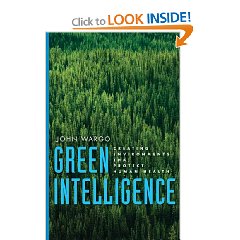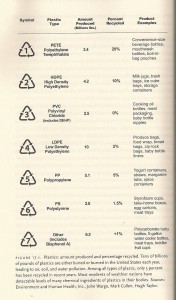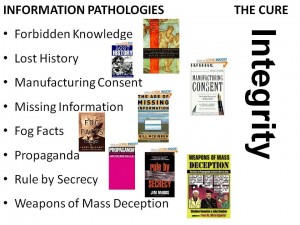
Among the books I recommend (and have reviewed) for more detailed insights:
Pandora's Poison: Chlorine, Health, and a New Environmental Strategy
High Tech Trash: Digital Devices, Hidden Toxics, and Human Health
Exposed: The Toxic Chemistry of Everyday Products and What's at Stake for American Power
The Blue Death: The Intriguing Past and Present Danger of the Water You Drink
Blue Frontier: Dispatches from America's Ocean Wilderness
The Next Catastrophe: Reducing Our Vulnerabilities to Natural, Industrial, and Terrorist Disasters
Big-Box Swindle: The True Cost of Mega-Retailers and the Fight for America's Ind
Ecological Economics: Principles And Applications
This book would normally have been a four on the substnace of the five domains, especially if one is looking for more in-depth appreciations, but I found the Notes and the Index satisfactory, and the intelligence-information perspective that this author makes a special effort to address carries the book most easily to a solid five.
Highlights from my fly-leaf notes:

+ 80,000 synthetic components that have not been evaluated alone or in combination
+ EPA studies and regulates “one chemical at a time,” has absolutely no ability to contemplate combinations that are additive, synergistic, or antagonistic
+ There has never been a master plan for environmental law as the same time that “the problems we now face are far more subtle, decentralized, and imperceptible.”
+ 90% of the chemicals are exempt from Federal review due to grandfathering or other loopholes
+ ZERO information is available for 43% of those 90% that are exempt, and limited basic information is available for another 7% of the 90%
+ 95% of the information that *is* provided to the federal government about chemicals is classified “confidential business information” that cannot be shared with state, local, or foreign governments, much less the public
+ The recurring theme across all five areas of concern is “strategies of public deception” by both the corporations and the federal agencies responsible for oversight of the corporations.
+ Lack of public knowledge is the most fundamental obstacle to effective safeguards.
+ QUOTE (xxi): “The underlying causes of our ignorance include illiteracy, secrecy, deception, privacy, language barriers, and perhaps most importantly, the control and ownership of science by powerful institutions.”
+ Classification of the atomic testing program prevented informed challenges leading to over a decade of primitive open air testing combined with an inability to predict weather patterns that poisoned a good two thirds of the continental United States at one time or another.
+ Human testing of nuclear effects was done without disclosure or informed consent
+ Three big concerns: persistent human incapacity to manage highly hazardous materials; failure to warn populations; and failure to have serious contingency plans (e.g. all our nuclear power plants are close to major urban centers)
+ Vieques island a single DoD training site for a long time, has, as a very low estimate, 45,000 unexploded bombs in the waters around the island.
+ DoD has gone for decades without understanding the consequences of its training emissions (fluids as well as emissions) on ground water–as I write this, there is a case breaking at Camp Lejeune).
+ 1200 licensed pesticides, many of them “parked” in a “special review” limbo, political speak for okay to use while we avoid understanding this
+ Vehicle emissions include “a highly diverse mixture of hazardous contaminants including particulates, ozone, nitrogen oxides, and volatile ‘air toxics' such as benzene.” (p 207)
+ Over half the U.S. population lives in countries that have not and will not meet federal standards
+ Of thousands of air pollutants, EPA monitors only six types, and the matter of how and when those six types are measures is subject to criticism
+ Indoor air is of concern in 30-50 of the buildings today; 107 active pesticides have been approved from indoor use
+ Air pollution now kills more than breast and prostate cancer combined (not sure what that really means)
+ 9% of kids in the USA suffer from asthma–this I understand, and it especially means urban poor kids.
+ Plastics are neither tested nor labeled. At Phi Beta Iota I am posting an image from page 268
+ There are two islands of plastic debris in the Pacific that are twice the size of Texas (!)
INFORMATION PATHOLOGIES OF LABELS
– labels not seen by those who are exposed to the application
– Illiteracy blocks understanding of labels when seen
– Only address proven adverse effects
– Safety claims often unproven
– Information about many adverse effects withheld
– Warnings are seldom updated
– Labels to not adequately explain hazards
– Applicators (humans) often are poorly trained
– Residues persist longer than most realize
– Labels often use confusing language
– Pesticides are often not tested thoroughly
– Labels often use misleading imagery
– Unsubstantiated claims of effectiveness
LESSONS LEARNED ACROSS THE FIVE AREAS
+ Secrecy shuts the public out and makes accountability impossible
+ Alternative uses of money not debated: for $5.5 trillion we spent on the US nuclear testing and armaments program from 1960-1990, what could we have done for America and the world?
+ EPA is clueless about the holistic challenge of testing all chemicals all the time in all contexts
+ Cost of restoring land now that we understand what we have done is a major obstacle to doing so
CONCLUSION
QUOTE: “The central problem is widespread public misunderstanding of the presence and danger of chemicals in everyday environments.” (p. 283)

Principles for Intelligence Gathering
+ Track the sources and movements of hazardous chemicals and technologies
+ Pay attention to persistence and mobility
+ Determine where the chemicals come to rest
+ Develop a thorough understanding of exposure
+ Improve toxicity testing
+ Account for variations in susceptibility
“True cost” does not appear in this book, that is a surmountable flaw that I recommend the author address in future editions of the book, which I do consider worthy of a second printing.




